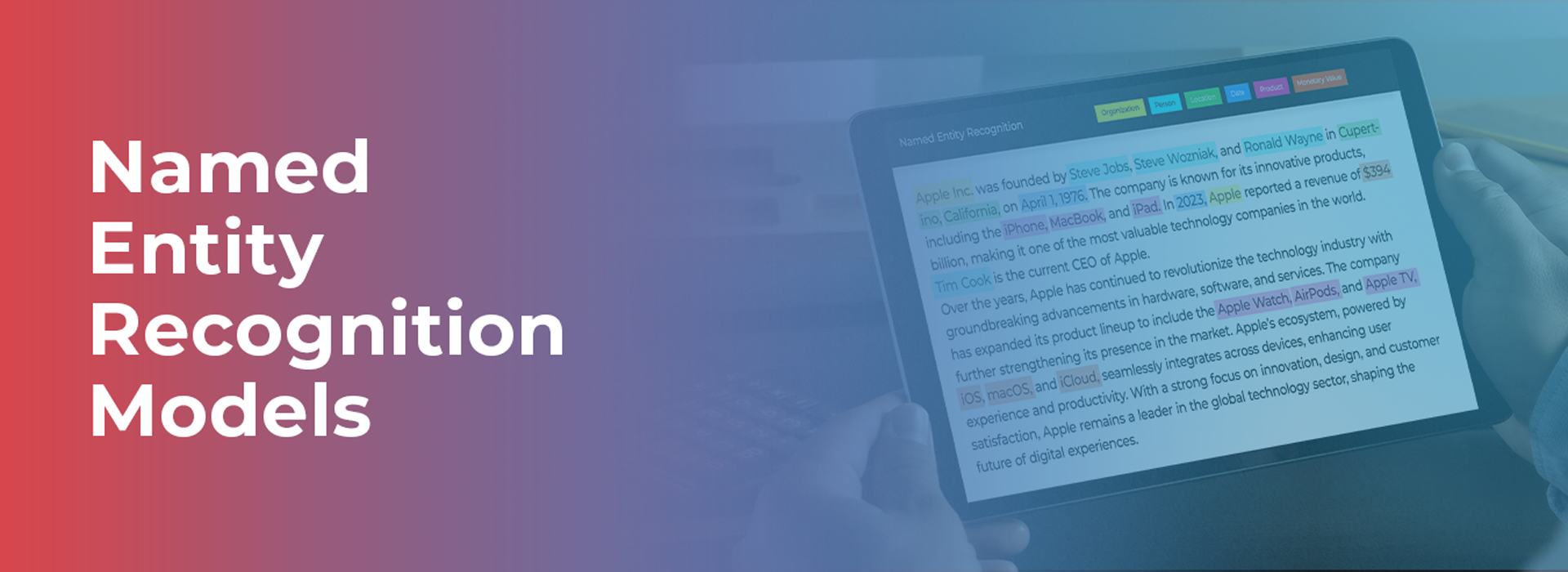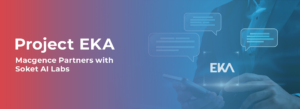- What Is Named Entity Recognition Models?
- Why Is NER Important in Data Science and NLP?
- Rule-based vs. Machine Learning NER Models
- A Deep Dive Into Popular NER Models
- Evaluation Metrics for NER Models
- Real-world Applications of NER
- Best Practices for Training and Deploying NER Models
- The Future of NER Technology
A Complete Guide to Named Entity Recognition Models
The underlying dimension of NER of Natural language processing is of utmost importance for data scientists, NLP researchers, and developers. NER, as a system, acts as a center for many data science enthusiasts. It acts as a key that opens the possibility of obtaining information from a big pile of unstructured data or text. But what NER is, is still a question. So let us examine it and look into its models, applications, and future trends.
What Is Named Entity Recognition Models?
Named Entity Recognition Models, commonly referred to as NER, is a sub-task of NLP that involves identifying and classifying entities in text into predefined categories such as names of persons, organizations, locations, dates, and more. For example, in the sentence “Apple released the new iPhone in Cupertino on September 12,” NER correctly identifies:
- Apple as an Organization
- Cupertino as a Location
- September 12 as a Date
NER enables systems to structure textual data for further processing, offering clearer insights and actionable information.
Why Is NER Important in Data Science and NLP?
NER has revolutionized how automated systems understand and interact with human language. Its significance spans across:
1. Data Structuring
NER transforms messy, unstructured text into organized data forms, making analysis easier and more insightful.
2. Enhanced Search Engine Efficiency
Search engines use NER to refine user queries and deliver more accurate results (e.g., interpreting search terms involving names or locations).
3. Content Categorization
NER helps automatically tag content with relevant entities, enabling better organization and retrieval in news, blogs, and e-commerce portals.
4. Business Intelligence
By extracting relevant entities, such as product names or key competitors mentioned online, businesses can make data-driven decisions faster.For companies like Macgence, which provides data to train AI/ML models, NER contributes significantly by improving the quality of training datasets for advanced machine learning applications, ensuring their accuracy and relevance.
Rule-based vs. Machine Learning NER Models
When it comes to building NER models, there are two primary approaches:
Rule-based Models
These models use predefined linguistic rules and patterns to identify entities. While rule-based systems are effective for simple use cases, they lack scalability for complex languages with unpredictable patterns.
Machine Learning Models
Machine learning models, on the other hand, learn to identify entities through large amounts of labeled training data. With supervised learning, these models outperform rule-based ones in accuracy, flexibility, and scalability.
A Deep Dive Into Popular NER Models
NER models have come a long way, powered by innovations in deep learning. Below, we explore the leading models dominating this space.
1. BERT (Bidirectional Encoder Representations from Transformers)
BERT is a well-known transformer model in NLP which was developed by Google. For example, what sets this model apart is that it features contextual embeddings, that is, it is able to comprehend how words in a given sentence relate to one another. Consequently, this aids to be quite effective for tasks such as Named Entity Recognition (NER) models.
2. GPT-3
A language model developed by OpenAI, GPT-3 is highly proficient in entity name recognition. GPT-3’s strength lies in the processing and predicting language sequences which allows developers to extract entities without significant modifications.
3. SpaCy
SpaCy is a free to use natural language processing library which is optimized for production tasks. It has a built-in named entity recognizer that is efficient and precise. This makes it suitable for practical tasks such as extracting names of organizations from legal documents or retrieving the dates from customer feedback.
Evaluation Metrics for NER Models
Assessing the performance of a named entity recognition model is crucial to ensuring its effectiveness in practical applications. The most common evaluation metrics include:
- Precision: Measures the percentage of correctly identified entities out of all predicted entities.
- Recall: Measures how many actual entities were accurately captured.
- F1 Score: A harmonic mean of precision and recall, providing an overall performance score.
For production-oriented environments like those supported by Macgence, emphasis on metrics such as the F1 score ensures the reliability and scalability of AI-driven solutions.
Real-world Applications of NER
NER is indispensable in solving real-world challenges across industries:
- Healthcare: Extracting disease names, medication information, and patient data from medical records.
- Finance: Identifying entities like bank names, credit card numbers, and transaction dates in financial documents.
- E-commerce: Tagging products, brands, and categories for better search and recommendation systems.
- Legal: Analyzing contracts and court case documents to extract critical entities like lawyer names, client information, and legal proceedings.
Best Practices for Training and Deploying NER Models

Building a robust named entity recognition model requires attention to detail. Here are some best practices:
- Prepare High-quality Training Data
Use diverse, labeled datasets that reflect the language complexity of your target domain.
- Leverage Pre-trained Models
Save time and resources by fine-tuning pre-trained models like BERT or GPT-3 to suit your use case.
- Monitor Performance Continuously
Deploy evaluation metrics such as the F1 score in regular monitoring systems to ensure the deployed model remains accurate over time.
- Integrate Feedback Loops
Allow users or systems to flag incorrect predictions, enabling iterative improvements in your model.
The Future of NER Technology
The future of named entity recognition is exciting and dynamic. With advancements in transformer models, we can expect:
- More context-aware models that capture nuanced meanings of text.
- Support for low-resource languages, breaking language barriers in AI tasks.
- Integration into multimodal models capable of understanding text in conjunction with images and audio.
Emerging trends in the development of real-time and low-energy NER models also hold immense potential for enterprise applications.
How to Start Leveraging NER with Macgence
There’s no doubt that modern machine learning approaches to data segmentation will improve our ability to process and make sense of huge volumes of data. That’s why at Macgence, we focus on collecting precise data that facilitates AI/ML model training as we believe it helps businesses take more advantage of NER.
Explore how NER can revolutionize your operations by reaching out to us today. Together, we create smarter AI solutions.
FAQs
Ans: – High-quality, labeled datasets that include annotations for entities like persons, organizations, and locations are crucial for training NER models effectively.
Ans: – Yes, most advanced NER systems can process multiple languages, but their accuracy depends on the availability of robust multilingual training datasets.
Ans: – Macgence provides diverse and high-quality data to train custom AI/ML models, ensuring your NER implementation delivers precise and actionable results.
You Might Like
February 28, 2025
Project EKA – Driving the Future of AI in India
Spread the loveArtificial Intelligence (AI) has long been heralded as the driving force behind global technological revolutions. But what happens when AI isn’t tailored to the needs of its diverse users? Project EKA is answering that question in India. This groundbreaking initiative aims to redefine the AI landscape, bridging the gap between India’s cultural, linguistic, […]
March 7, 2025
What is Data Annotation? And How Can It Help Build Better AI?
Spread the loveIntroduction In the world of digitalised artificial intelligence (AI) and machine learning (ML), data is the core base of innovation. However, raw data alone is not sufficient to train accurate AI models. That’s why data annotation comes forward to resolve this. It is a fundamental process that helps machines to understand and interpret […]
March 6, 2025
Vertical AI Agents: Redefining Business Efficiency and Innovation
Spread the loveThe pace of industry activity is being altered by the evolution of AI technology. Its most recent advancement represents yet another level in Vertical AI systems. This is a cross discipline form of AI strategy that aims to improve automation in decision making and task optimization by heuristically solving all encompassing problems within […]
March 5, 2025
Use of Insurance Data Annotation Services for AI/ML Models
Spread the loveThe integration of artificial intelligence (AI) and machine learning (ML) is rapidly transforming the insurance industry. In order to build reliable AI/ML models, however, thorough data annotation is necessary. Insurance data annotation is a key step in enabling automated systems to read complex insurance documents, identify fraud, and optimize claim processing. If you […]


 Previous Blog
Previous Blog







